Ten years ago, it ignited the imagination of decentralization with a white paper. Ten years later, it remains at the core of the crypto world, but it is no longer the only stage.
Written by: ChandlerZ, Foresight News
Over the past century, humanity has redefined the form of computers several times.
From the massive computers born in the mid-20th century for rocket navigation, to IBM pushing mainframes into enterprises, to Microsoft and Apple bringing personal computers into homes, and then smartphones putting computers into everyone's pockets.
Each leap in computing power has reshaped the way people connect with the world.
In 2013, 19-year-old Vitalik Buterin, while playing World of Warcraft, seriously pondered a question for the first time: In the digital world, who guarantees that the rules won't be arbitrarily rewritten?
If there were a "world computer" that did not belong to any company, was not controlled by a single power, and could be used by anyone, could it become the starting point for the next form of computing?
On July 30, 2015, in a small office in Berlin, dozens of young developers stared at the block counter. At the moment the number jumped to 1,028,201, the Ethereum mainnet automatically launched.
Vitalik recalled: "We were all sitting there waiting, and then it finally reached that number, and about half a minute later, it started generating blocks."
At that moment, the spark of the world computer was ignited.
Starting Point and Spark
At that time, Ethereum had fewer than a hundred developers. It was the first to embed smart contracts into the blockchain, providing a Turing-complete stage that transformed the blockchain from merely a bookkeeping tool into a world-class public computer capable of running programs.
Soon, this nascent world computer faced severe tests.
In June 2016, a major security incident occurred with the decentralized autonomous organization "The DAO" based on Ethereum, where hackers exploited vulnerabilities in smart contracts to steal approximately $50 million to $60 million worth of Ether. The community engaged in intense discussions about whether to "rollback history," ultimately choosing a hard fork to recover the assets, which led to the split of another chain—Ethereum Classic.
This incident brought the governance issue of the world computer to the forefront for the first time: Should we uphold immutability, or correct mistakes to protect users?
The ICO boom from 2017 to 2018 pushed Ethereum to new heights, with countless projects issuing tokens through Ethereum, raising billions of dollars, and driving ETH prices to soar. However, the subsequent bubble burst plunged Ethereum into a downturn, with ETH prices dropping over 90% from their peak at the end of 2018, and the network faced criticism for congestion and high fees. During that period, the popularity of CryptoKitties even caused the mainnet to become congested to the point of near paralysis, exposing the limitations of insufficient computing power for the first time.
To address performance bottlenecks, the Ethereum community began researching on-chain sharding solutions as early as 2015, attempting to improve throughput by splitting node verification loads. However, the implementation of sharding technology is complex and progress has been slow. Meanwhile, developers also explored off-chain scaling paths, from early state channels and Plasma to the Rollup solutions that emerged in 2019. Rollup significantly enhances processing capacity by bundling a large number of transactions for mainnet verification, but it requires the mainnet to provide sufficient data availability support. Fortunately, around 2019, Ethereum made breakthroughs in data availability, solving the problem of large-scale data verification.
Subsequently, Ethereum gradually formed a scaling route of "mainnet security, layer two execution," and the world computer began to decompose into a multi-layer collaborative system.
In the following years, DeFi exploded on Ethereum, with decentralized lending, trading, and derivatives emerging like mushrooms after rain; the NFT craze pushed digital art into the mainstream, with Beeple's work selling for $69 million at Christie's. Although the network's prosperity was accompanied by persistently high fees, Ethereum began to respond by improving its protocol. In August 2021, the EIP-1559 upgrade implemented a base fee burning mechanism, destroying the base fee of each transaction in ETH, thereby reducing inflationary pressure during periods of high demand. This reform led to a brief net deflation of ETH during the 2021-2022 bull market, driving its price to nearly $4,900, a historical high.
On September 15, 2022, The Merge was completed, switching the core energy of the world computer from the energy-intensive PoW to PoS, reducing energy consumption by 99% and new issuance by 90%. ETH holders began participating in the network through staking, completely overhauling the energy system of this world computer.
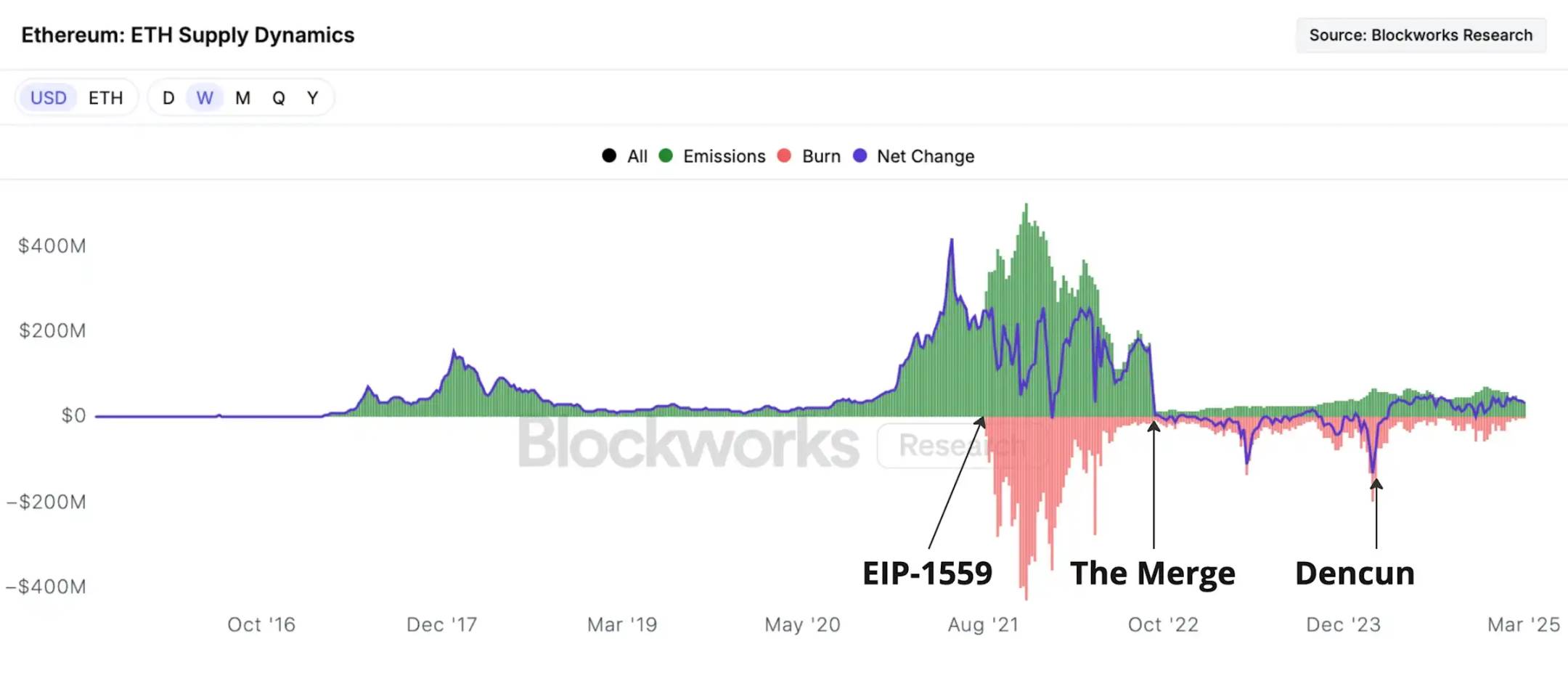
Data from a year after the Merge shows that Ethereum's net supply has decreased by approximately 300,000 ETH, forming a stark contrast to the amount that would have been issued under the PoW mechanism. This deflationary characteristic has strengthened market expectations of ETH scarcity.
After undergoing the aforementioned transformations, by the end of 2023, both the performance and economic mechanisms of the Ethereum mainnet had improved, but new challenges also emerged. To reduce fees and encourage Rollup development, Ethereum will implement the "Dencun" upgrade (Deneb + Cancun) in March 2024, introducing EIP-4844, the so-called Proto-Danksharding technology. This improvement adds special "data blob" transactions for Rollup to submit batch transaction data. Since blob data is only stored temporarily, the cost is much lower than that of ordinary call data, significantly reducing the fees for layer two networks to submit data to the mainnet. The successful launch of Dencun marks a significant reduction in Rollup costs, bringing the world computer one step closer to the goal of sharding.
Ten years have passed, and this world computer has transformed from the ideal in the white paper into an irreplaceable infrastructure in reality.
However, behind the brightly lit nodes, new dilemmas have quietly emerged…
The Fog of Middle Age
As we enter 2024-2025, the dilemmas facing Ethereum are becoming increasingly apparent.
Significant Layer 2 Diversion Effect
The Rollup-centric route that Ethereum has embraced in recent years has alleviated pressure on the main chain but has also caused a large number of transactions and value to remain on layer two networks, failing to flow back to the mainnet. A report from Standard Chartered in early 2025 bluntly stated that the rise of layer two networks has eroded the value capture of the Ethereum main chain. The report estimates that just the leading Ethereum layer two, Base, launched by Coinbase, has "taken away" about $50 billion in market value from the Ethereum ecosystem.
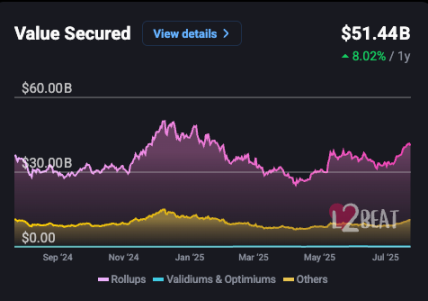
Transactions and applications that could have occurred on the mainnet have shifted to the lower-cost L2, leading to a decrease in transaction fee revenue and on-chain activity for the mainnet. This trend became more pronounced after the Dencun upgrade, as EIP-4844 significantly reduced the costs for Rollup to submit data to the mainnet, further enhancing the attractiveness of L2 for handling transactions. In recent years, the daily transaction numbers of Rollups like Arbitrum and Optimism have repeatedly matched or even exceeded those of the main chain, validating the scenario of "Ethereum outsourcing transaction execution."
In other words, the components of the world computer are operating efficiently externally, but the value capture ability of the mainframe is being eroded.
Intensifying Competition from External Public Chains
Due to Ethereum's early performance and cost shortcomings, many competitors have attempted to provide faster and cheaper alternatives.
For example, Solana, which focuses on high throughput, has attracted a large number of developers, with most new and MEME projects in this bull market primarily laying out on Solana; in the stablecoin sector, Tron has leveraged its near-zero transfer fees to support the massive issuance and transfer of mainstream stablecoins like USDT. The USDT circulating on the Tron chain has now exceeded 80 billion, surpassing Ethereum to become the largest stablecoin network, with transaction volumes far exceeding those of Ethereum. This means that in the critical stablecoin arena, Ethereum has relinquished its dominant position.
Moreover, public chains like BNB Smart Chain have also captured some traffic from GameFi and altcoin trading. Although Ethereum still has the largest number of DeFi protocols and TVL, accounting for about 56% of DeFi activity in the entire industry as of July 2025, it is undeniable that under the multi-chain coexistence pattern, Ethereum's relative dominance has declined from its peak.
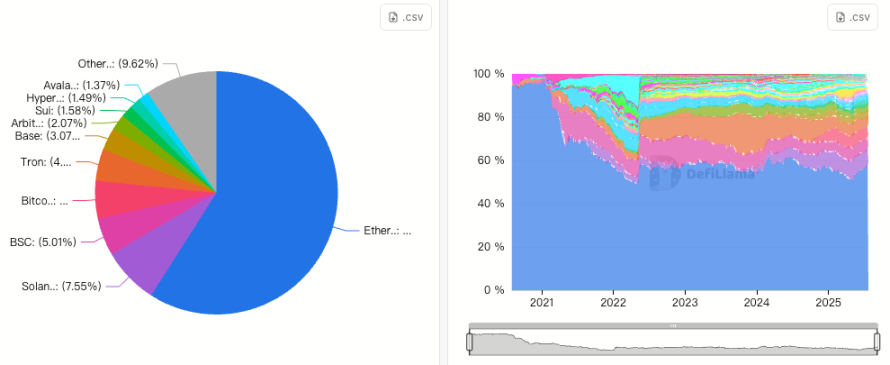
Governance and Security Concerns
After transitioning to PoS, concerns about staking centralization have arisen within the community. According to the rules, participating in Ethereum network validation requires a staking threshold of 32 ETH, which has led retail investors to participate through staking pools or exchanges, resulting in a situation dominated by a few large staking service providers. The largest decentralized staking pool, Lido, once held over 32% of the staking market share across the network. As more competitors entered, Lido's share slightly decreased to about 25%, but it still far outpaces its nearest competitors, Binance (about 8.3%) and Coinbase (about 6.9%). The community is generally worried that if any single entity holds more than 1/3 of the validation weight, it could potentially impact block consensus and even network security.
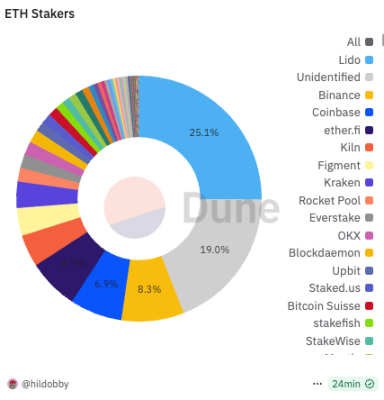
Vitalik has called for limiting the share of any single validating entity through fee rate restrictions, for example, keeping it below 15%. However, in the 2022 Lido governance vote, a proposal to set a self-limit cap was rejected by over 99% of the votes. Currently, according to Dune data, there are over 1.12 million validators on the Ethereum network, with a total of over 36.11 million ETH staked, accounting for 29.17% of the total supply. How to promote the diversification of staking participants without sacrificing network security remains an unresolved issue.
Controversial Role of the Foundation
Over the years, the foundation has been criticized for lacking transparency in ecological funding and financial management, with the community often questioning its sale of holdings at ETH peaks and lack of public explanations. Some early developers believe that the foundation's "hands-off" approach has led to a continuous accumulation of ecological fragmentation and narrative confusion, making it difficult to form an effective governance system.
Meanwhile, the voices of opinion leaders have gradually faded. Vitalik and several early developers still hold significant influence, but they rarely make clear statements on key directions. They choose restraint, avoiding influencing market sentiment and steering clear of governance disputes. In the long run, this restraint has created another kind of vacuum: the community lacks consensus, with no one willing to take responsibility for decisions, and many proposals lack advocates. Open discussions have decreased, and technical routes and ecological strategies have shifted more towards closed-door discussions.
Without a clear helmsman, the world computer, while operational, lacks a sense of direction for moving forward.
The Blank Application Layer and Unsatisfactory Market Performance
If Ethereum hopes to become the world computer on-chain, its value should not only lie in providing computing power and security at the base level, but in its ability to support a continuous stream of new applications and experiences, allowing developers and users to see the boundaries of imagination being constantly pushed.
However, after ten years, the applications that have truly been validated by the market and achieved scalable success remain limited to DeFi and NFTs. Beyond that, the application layer appears to be quiet.
Promising directions such as social networking, gaming, identity, and DAOs have yet to produce phenomenally successful products comparable to DeFi and NFTs.
Web3 social platforms like Friend.tech and Lens once surged in popularity but quickly lost traction, with very low retention rates; on-chain games generated much discussion but mostly remained simple token economic experiments, struggling to enter the mainstream; decentralized identity and DAO governance still largely remain in the realm of technical exploration and small-scale experiments.
On-chain data confirms this deficiency. In July 2025, the daily amount of ETH burned on the Ethereum network fell below 50, setting a new historical low, a stark contrast to the nearly 1,000 ETH burned daily during the frenzy of 2021.
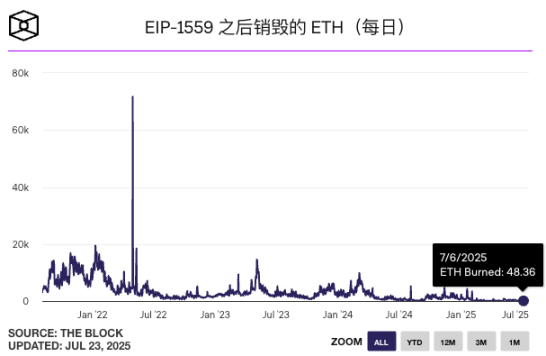
During the same period, the 7-day average number of active addresses dropped to about 566,000, failing to reach the highs seen since March 2024; the number of new addresses added daily was around 120,000, with monthly on-chain transaction volumes hovering around 35 to 40 million.
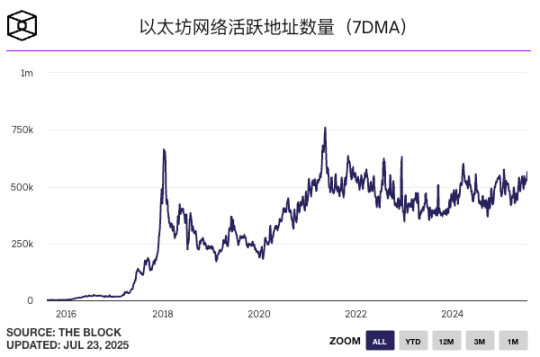
For a network that prides itself on being a world computer, this signifies a lack of the spark needed to ignite a new wave of large-scale applications.
Ethereum boasts the largest developer community in the industry and is not lacking in technical reserves, yet it has yet to find that killer application capable of attracting tens of millions of new users and changing usage habits. Ten years later, this machine remains powerful but is still searching for its next mission.
This stagnation at the application layer is also reflected in market performance. ETH approached a historical high of nearly $4,900 in November 2021, but has not surpassed that level in the years since. The boosts from the Merge and fee reforms have been limited, with price trends from 2022 to 2024 consistently lagging behind Bitcoin, Solana, and even BNB. As we enter 2025, other crypto assets frequently set new records, while ETH's price still hovers just above $3,000, with the ETH/BTC ratio even briefly falling below 0.02 in April, marking a multi-year low. Once regarded as the fuel for the smart contract domain, ETH's wealth effect in the market is diminishing.
Recently, strategic allocations from publicly traded companies and institutions have provided some support for ETH. Companies like Sharplink Gaming and BitMine have publicly disclosed treasury strategies, issuing convertible bonds, preferred stocks, and market offerings to raise funds for increasing their ETH holdings. Unlike Bitcoin, ETH can generate protocol-level returns through staking and re-staking, making it a "yield-bearing" digital asset in corporate treasuries. This native yield characteristic gives it a certain appeal. Within weeks, ETH's price rebounded from its lows to above $3,600.
However, some analyses point out that this recent warming is more a result of proactive capital allocation rather than a significant leap in the on-chain ecosystem itself. The price rebound is not accompanied by developer innovation and user influx, but rather resembles a stopgap choice as market funds seek targets.
Technological advancements and institutional entry cannot replace applications that truly change user habits and unleash new demands.
Ten years after its inception, Ethereum still needs to answer that initial question: as a world computer, what kind of programs should it run to reignite global imagination?
The Unfinished Path: Directions for the Next Decade
In the face of internal and external challenges during its middle age, whether Ethereum can emerge from its low point depends on whether its technology and ecosystem can open up new growth spaces.
Technology: Making the World Computer Faster and More Unified
The community has already outlined an upgrade blueprint for the post-Merge era.
In his article "The Possible Future of Ethereum: The Surge," Vitalik articulated that the core goal of the next phase is to enhance the overall throughput capacity of the mainnet and layer two networks to 100,000 transactions per second while maintaining L1 decentralization and robustness. It is also essential to ensure that at least some L2s can fully inherit Ethereum's core characteristics (trustlessness, openness, censorship resistance) and to make the entire network experience feel more like a unified ecosystem rather than 34 fragmented blockchains. This means that future transfers across L1/L2, capital flows, and application switches will become as seamless as operations within a single chain.
The EIP-4844 in 2024 is just the starting point, with subsequent introductions of data sampling and compression technologies.
As zero-knowledge proof technologies like ZK-SNARK and ZK-STARK mature, performance bottlenecks are expected to be broken, and users who previously overflowed to other public chains and L2s may return.
Governance and Economics: How the Main Chain Can Regain Value
Not only performance, but Ethereum is also contemplating how to ensure that the core of the world computer continues to capture value.
In July 2025, the Ethereum Foundation launched a new structural reform called "The Future of Ecosystem Development," attempting to step out from behind the scenes to become the helmsman guiding ecological development. The foundation proposed two long-term goals: to maximize the number of people directly or indirectly using Ethereum and benefiting from its underlying values, and to enhance the resilience of technology and social infrastructure.
To this end, the foundation has restructured around four pillars: "Accelerate, Amplify, Support, and Long-term Unblocking," reorganizing internal teams and establishing modules for corporate relations, developer growth, application support, and founder support, while strengthening the team's content and narrative to enhance community cohesion.
The foundation also committed to increasing transparency, emphasizing more targeted public product funding, launching a Launchpad to support governance and sustainable operations, while reducing operational expenditure ratios and establishing a funding buffer for about 2.5 years.
The external community generally views this series of actions as a substantial adjustment in response to criticisms of the foundation's hands-off approach, and it is seen as a boost for its next decade.
In community discussions, new ideas have also emerged: Can a portion of the profits be extracted from the prosperity of Layer 2? Or can the protocol fee and MEV distribution mechanisms be optimized to allow the main chain to share in the growth dividends during the Rollup era? These proposals are still under exploration but reflect a common concern—if proactive adjustments are not made, the main chain may regress to being merely a settlement layer, with its value and vitality continuously diluted.
Searching for New Sparks at the Crossroads
Technology and capital alone are not enough.
Every peak of Ethereum in the past has been ignited by new applications and narratives. Now, the entire blockchain industry is in a period of innovation stagnation, lacking any phenomenal breakthroughs.
Perhaps the blockchain itself needs a self-revolution, generating new narratives and applications in areas like social networking, identity, and AI. Some believe that the next breakthrough may come from external ecological shocks.
Vitalik further reminded in his speech "The Next Decade of Ethereum" that Ethereum developers should not merely replicate Web2 but should look towards future interaction forms, including wearable devices, AR, brain-computer interfaces, and local AI, incorporating these new entry points into the design vision of Web3.
Looking back over the past decade, Ethereum still possesses the largest developer community in the industry, the richest applications, and deep technical accumulation. However, it is facing a moment of bottlenecks, competition, and new births.
As Vitalik said, "The past decade of Ethereum has been a decade focused on theory. In the next decade, we must change our focus and think about what impact we can have on the world." In his view, the next generation of applications must not only have different functionalities but also retain shared values, and these applications must be user-friendly enough to attract those who have yet to enter the crypto space.
The world computer is experiencing its ten-year itch. It has not stopped operating; it is merely searching for a new direction.
The next decade belongs to it and to everyone who still believes in this dream.
But as Vitalik said, "Everyone who speaks in the Ethereum community has the opportunity to participate in the process of building the future together."
免责声明:本文章仅代表作者个人观点,不代表本平台的立场和观点。本文章仅供信息分享,不构成对任何人的任何投资建议。用户与作者之间的任何争议,与本平台无关。如网页中刊载的文章或图片涉及侵权,请提供相关的权利证明和身份证明发送邮件到support@aicoin.com,本平台相关工作人员将会进行核查。




